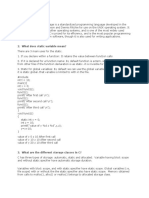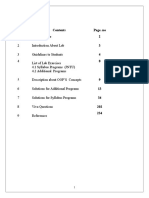Modular Programming: 2.1. The Notion of A Module
Modular Programming: 2.1. The Notion of A Module
Uploaded by
Serban PetrescuCopyright:
Available Formats
Modular Programming: 2.1. The Notion of A Module
Modular Programming: 2.1. The Notion of A Module
Uploaded by
Serban PetrescuOriginal Description:
Original Title
Copyright
Available Formats
Share this document
Did you find this document useful?
Is this content inappropriate?
Copyright:
Available Formats
Modular Programming: 2.1. The Notion of A Module
Modular Programming: 2.1. The Notion of A Module
Uploaded by
Serban PetrescuCopyright:
Available Formats
Iosif Ignat Laboratory Guide 5.
Modular programming
T.U. Cluj-Napoca Computer Programming 1
MODULAR PROGRAMMING
1. Overview
The learning objectives of this lab session is to:
Understand the concepts of modules, modular programming, and variable scope.
Learn how to develop applications using modules
2. Brief theory reminder
2.1. The notion of a module
A source module is a part of the source code of the program, which is compiled separately from
the rest of the source code.
An object module is the result of the compilation of a source module.
A module contains related functions, as they are developed for solving a subproblem. Actually,
the modules of a program correspond to the subproblems which result from a top-down design for
solving a complex problem.
Modular programming is the programming style which is based on using modules. By using
modular programming, a programmer can valuate the possibilities of hiding data and procedures to
protect against unauthorized access form other modules. Thus, static data declared outside the
functions of a module may be accessed by all those functions, but they are not accessible by
functions of other modules.
It is strongly recommended to write modular solutions for complex programs, as this facilitates
teamwork.
Modularization of a program also speeds up implementation and testing.
Tuned modules can be later used for solving other problems.
When solving complex problems, an executable can be obtained in the following ways:
Write a number of source files, each containing a module. Every module must be debugged and
tuned separately. Using the construct:
#include file_specifier
1. One can include the source code either in the module which contains the main() function, or
in a file which contains only module inclusion directives, also including the module which
contains main(). This method actually produces a single source program, which will be
compiled, linked and then executed. As the whole code is recompiled all the time, we do not
advise for the use of this method.
2. Write separate source modules, and compile them separately, resulting in a number of object
files (typically with the extension .obj). Link them and obtain the executable. Source modules
can be separately compiled and then linked together by using projects in Dev-C++. This is
our recommended method.
2.2. The scope of variables
2.2.1. Global variables
Global variables are defined at the beginning of a source file, i.e. before any function definition. These
variables are visible from the point of definition to the end of the source file. If a program uses more
than one source file, a global variable defined in one source file can be used in all the other source
files if it is declared extern. Declaration of an extern variable can be done:
Iosif Ignat Laboratory Guide 5. Modular programming
T.U. Cluj-Napoca Computer Programming 2
After a function header, but then the scope of the variable is only that function.
At the beginning of the source file, i.e. before the first function. Then its scope is the whole
file (all functions in that file have access to it).
Note: It is recommended that the extern variables to be declared as extern in every function where
they are used, thus avoiding the errors which can arise as a result of moving a function to a different
module.
Global variables are allocated at compile time, in a special area.
2.2.2. Local variables
Variables declared in a function or in a composite statement are visible only within the unit
where they were declared. Local variables can be:
a) automatic variables which are allocated on the stack, at execution time. They are
discarded upon return form a function, or at the end of the composite statement (block).
The syntax for declaring them is the usual one (e.g. int a, b, c; double x; etc.);
b) static variables which are allocated at compile time in a special area. Their declaration
uses the keyword static before the type of the variable. Example:
static int x, y, z;
A static variable can be declared:
- At the beginning of a source file (i.e. before the first function declaration). In this case,
the static variable is visible in the whole source file, but it cannot be declared extern (and
thus made visible) in other files.
- In the body of a function, case in which its scope is only that function, or in a block
(composite statement), and then its scope is that block.
register variables which are allocated in the registers of the processor. Their type can be
only integer, character, and pointer. Its is advised to declare as register variables frequently
used variables in a function. The number of register variables is limited. If many were
declared, the ones which cannot be allocated in registers, are allocated on the stack., as
automatic variables. Modern compilers do their own optimization of register usage, making
this declaration obsolete. A register variable declaration uses the keyword register:
register type variable;
Register variable allocation scope is the function where they were declared.
2.3. Modularized program example
The following program computes the reciprocal matrix and the determinant of a square
matrix with elements of type double. The program was divided into modules as follows:
File L5Ex1_1.cpp contains a function for reading the dimensions and elements of a matrix, and
a matrix display function, i.e. functions performing I/O operations:
/* Read and display of a n*m element matrix with elements of type double */
#include <stdio.h>
#define MAXN 10
void display_matrix(int n, int m, double a[MAXN][MAXN], char ch)
{
int i, j;
Iosif Ignat Laboratory Guide 5. Modular programming
T.U. Cluj-Napoca Computer Programming 3
printf("\n MATRIX %c\n",ch);
for( i=0; i<n; i++)
{
for(j=0;j<m;j++) printf("%8.2lf ",a[i][j]);
printf("\n");
}
}
void read_matrix(int *n, int *m, double a[MAXN][MAXN])
{
int i,j;
printf("\nInput of size and elements of a matrix\n");
printf("\n\tNumber of rows, n=");
scanf("%d", n);
printf("\n\tNumber of columns, m=");
scanf("%d", m);
printf("\n\tThe elements of the matrix\n");
for (i=0;i<*n;i++)
for(j=0; j<*m; j++)
{
printf("a[%d,%d]=", i, j);
scanf("%lf",&a[i][j]);
}
printf("\n");
}
File L5Ex1_2.cpp contains a multiplication function for two matrices:
/* Compute the product of matrices a[n][m] and b[m][p], of type double.
The result is stored in matrix c[n[][p] */
#define MAXN 10
void multiply_matrix(int n, int m, int p, double a[MAXN][MAXN],
double b[MAXN][MAXN], double c[MAXN][MAXN])
{
int i, j, k;
double s;
for(i=0; i<n; i++)
for(j=0; j<p; j++)
{
s=0.0;
for(k=0; k<m; k++)
s=s+a[i][k]*b[k][j];
c[i][j]=s;
}
}
File L5Ex1_3.cpp contains a function used to compute the reciprocal matrix of a square matrix
and the value of its determinant.
/* Computes the reciprocal matrix of square matrix a of size n and
The value of its determinant, det_a, with precision eps */
#include <math.h>
#define MAXN 10
Iosif Ignat Laboratory Guide 5. Modular programming
T.U. Cluj-Napoca Computer Programming 4
void reciprocal_matrix(int n, double a[MAXN][MAXN], double eps,
double b[MAXN][MAXN], double *det_a, int *err)
{
int i, j, k, maxpos;
double amax,aux;
/* Initialize matrix b with the unit matrix */
for(i=0; i<n; i++)
for(j=0; j<n; j++)
if(i==j) b[i][j]=1.0;
else b[i][j]=0.0;
/* Initialization of the value of the determinant */
*det_a=1.0;
/* Set to 0 all the elements under the main diagonal,
and to 1 those on the diagonal */
k=0; /* k=row number */
*err=0;
while( (k<n) && (*err==0) )
{
/* Calculate the pivot element */
amax=fabs(a[k][k]);
maxpos=k;
for(i=k+1; i<n; i++)
if (fabs(a[i][k]) > amax)
{
amax=fabs(a[i][k]);
maxpos=i;
}
/* Interchange row k cu rwo maxpos in matrices a and b */
if(k!=maxpos)
{
for(j=0; j<n; j++)
{
aux=a[k][j];
a[k][j]=a[maxpos][j];
a[maxpos][j]=aux;
aux=b[k][j];
b[k][j]=b[maxpos][j];
b[maxpos][j]=aux;
}
*det_a=-*det_a;
}
if( fabs(a[k][k]) < eps) *err=1;
else
{
*det_a =*det_a*a[k][k];
aux=a[k][k];
for(j=0; j<n; j++)
{
a[k][j]=a[k][j] / aux;
b[k][j]=b[k][j] / aux;
}
for(i=0; i<n; i++)
if(i != k)
{
aux=a[i][k];
for(j=0; j<n; j++)
{
Iosif Ignat Laboratory Guide 5. Modular programming
T.U. Cluj-Napoca Computer Programming 5
a[i][j]=a[i][j]-a[k][j]*aux;
b[i][j]=b[i][j]-b[k][j]*aux;
}
}
}
k++;
}
}
File L5Ex1_4.cpp contains the main() function.
/* Program to compute the reciprocal matrix of a square matrix and Its determinant
value */
#include <stdio.h>
#include <stdlib.h>
#define MAXN 10
extern void display_matrix(int n, int m, double a[MAXN][MAXN], char ch);
extern void read_matrix(int *n, int *m, double a[MAXN][MAXN]);
extern void multiply_matrix(int n, int m, int p, double a[MAXN][MAXN],
double b[MAXN][MAXN], double c[MAXN][MAXN]);
extern void reciprocal_matrix(int n, double a[MAXN][MAXN], double eps,
double b[MAXN][MAXN], double *det_a, int *err);
int main()
{
int i, j, n, m, err;
double eps, det_a, a[MAXN][MAXN], a1[MAXN][MAXN],
b[MAXN][MAXN], c[MAXN][MAXN];
system("cls");
read_matrix(&n, &m, a);
display_matrix(n, m, a, 'A');
printf("Type Enter");
getchar();
for(i=0; i<n; i++)
for(j=0; j<n; j++) a1[i][j]=a[i][j];
eps=1.0e-6;
reciprocal_matrix(n, a1, eps, b, &det_a, &err);
if(err == 1) printf("\nMATRIx IS SINGULAR");
else
{
printf("\nReciprocal matrix B=A^(-1)\n");
display_matrix(n, n, b, 'B');
printf("\nDeterminant of matrix A IS %8.4lf", det_a);
multiply_matrix(n, n, n, a, b, c);
printf("\nCHECK THAT C=A*B RESULTS IN THE UNIT MATRIX.");
display_matrix(n, n, c, 'C');
printf("Type Enter");
getchar();
}
return 0;
}
Iosif Ignat Laboratory Guide 5. Modular programming
T.U. Cluj-Napoca Computer Programming 6
In order to build the program, place all files in a directory, open a new project in Codeblocks, remove
the predefined main and include all the above files in the project. Then build it.
3. Lab Tasks
3.1. Compile, execute and analyze the example program..
Write modular programs for solving the following problems:
3.2. Given an arithmetic expression in postfix form, with operands only integers, and only the
operators +, , *, / write a program to evaluate such an expression.
3.3. Write programs to calculate the greatest common divisor and the smallest common multiple for
two polynomials.
3.5. Implement sets and the operations on sets.
3.6. Implement a text editor which allows a number of operations on text (insert, delete/append
characters or lines, cut, paste, etc.).
3.7. Read the number of points, n, and their coordinates, (x, y) in the plane x0y, obtained as a
result of experiments. Approximate the function y=f(x) by a polynomial of degree m (m is also read
from the standard input), such a way that the sum of the squares of the approximation errors is
minimal. Hint: use the least squares method (see Numerical Recipes).
3.8. Read the number of towns in a region, n, and their coordinated (x, y) in the plane x0y . Find a
way of connecting them by telephone lines of minimal length, provided that every pair of towns is
connected either directly, or by intermediate(s).
You might also like
- Software SystemsDocument298 pagesSoftware SystemsShawn Barron100% (1)
- Gpss ManualDocument468 pagesGpss ManualElliot Reid100% (1)
- Configuration For Automatic Packing in Outbound DeliveryDocument14 pagesConfiguration For Automatic Packing in Outbound Deliverybiswajit100% (1)
- What Is C++?: How Do You Find Out If A Linked-List Has An End? (I.e. The List Is Not A Cycle)Document15 pagesWhat Is C++?: How Do You Find Out If A Linked-List Has An End? (I.e. The List Is Not A Cycle)Umesh BendreNo ratings yet
- What Is C++?: How Do You Find Out If A Linked-List Has An End? (I.e. The List Is Not A Cycle)Document26 pagesWhat Is C++?: How Do You Find Out If A Linked-List Has An End? (I.e. The List Is Not A Cycle)Balas KandhanNo ratings yet
- Interview QuestionsDocument24 pagesInterview QuestionsHarpreet RaiNo ratings yet
- C++ Interview Questions and AnswersDocument19 pagesC++ Interview Questions and Answerssailisurve424No ratings yet
- What Is C++?: C++ Interview Questions and AnswersDocument42 pagesWhat Is C++?: C++ Interview Questions and AnswerssimraniaNo ratings yet
- BC0037Document25 pagesBC0037rzsoNo ratings yet
- What Is C Language?Document7 pagesWhat Is C Language?Mizanur RahmanNo ratings yet
- BC0037 - Programming Using C++Document16 pagesBC0037 - Programming Using C++Nadeem MohammedNo ratings yet
- C++ Interview QuestionDocument29 pagesC++ Interview QuestioninamullhNo ratings yet
- Chapter Four FunctionsDocument10 pagesChapter Four FunctionsHabtie TesfahunNo ratings yet
- Master of Computer Application (MCA) - Semester II: MC0066 - OOPS Using C++ - 4 CreditsDocument37 pagesMaster of Computer Application (MCA) - Semester II: MC0066 - OOPS Using C++ - 4 Creditsクマー ヴィーンNo ratings yet
- Final - OOPJ Lab ManualDocument36 pagesFinal - OOPJ Lab Manualchavanpraful0525No ratings yet
- Computer Science - FAQDocument16 pagesComputer Science - FAQPriyansh JainNo ratings yet
- C Interview Questions and AnswersDocument63 pagesC Interview Questions and AnswerskakashokNo ratings yet
- Implementation of A Simple Calculator Using Flex and Bison: AbstractDocument5 pagesImplementation of A Simple Calculator Using Flex and Bison: AbstractPhuc VuongNo ratings yet
- Unit I Introduction to OOPDocument26 pagesUnit I Introduction to OOPamrutachougaleNo ratings yet
- C++ Inteview QuesDocument27 pagesC++ Inteview QuesAshish SinghNo ratings yet
- Bottom of Form C++ Interview Questions and Answers How Can You Tell What Shell You Are Running On UNIX System?Document42 pagesBottom of Form C++ Interview Questions and Answers How Can You Tell What Shell You Are Running On UNIX System?Sriram Madhav NimmagaddaNo ratings yet
- FunctionsDocument31 pagesFunctionsharsh00s11No ratings yet
- Itc Lab Report: OjectiveDocument5 pagesItc Lab Report: OjectiveMuhammad Moaz Awan FastNUNo ratings yet
- Exploring Python Functions Reading - FunctionsDocument9 pagesExploring Python Functions Reading - FunctionsnajmadeenNo ratings yet
- Function CCDocument6 pagesFunction CCAashish KumarNo ratings yet
- ADSA Lab ManualDocument225 pagesADSA Lab ManualjyothibellaryvNo ratings yet
- E Coop Re FactoringDocument2 pagesE Coop Re FactoringcrennydaneNo ratings yet
- Object Oriented Programming (Oop) Using C++: A Question BankDocument51 pagesObject Oriented Programming (Oop) Using C++: A Question BankAnonymous cnS2art5No ratings yet
- Module 3 Notes C ProgrammingDocument52 pagesModule 3 Notes C ProgrammingKhushi GuptaNo ratings yet
- Unit - 4 - III Cs - PythonDocument21 pagesUnit - 4 - III Cs - PythonjagethirameshNo ratings yet
- Intro To OOP in C++Document39 pagesIntro To OOP in C++takamjonathan07No ratings yet
- Sppu PPL Nov 2017 AnswersDocument15 pagesSppu PPL Nov 2017 Answersranjeetjagtap100% (1)
- User Defined FunctionsDocument19 pagesUser Defined Functionsprofessor240305No ratings yet
- Solution Sheet For Regular PYQ Paper 2023Document29 pagesSolution Sheet For Regular PYQ Paper 2023Juned KhanNo ratings yet
- Viva QuestionsDocument12 pagesViva QuestionssksaidaNo ratings yet
- Object Oriented ProgrammingDocument9 pagesObject Oriented ProgrammingArchit JindalNo ratings yet
- C++ Interview Questions inDocument34 pagesC++ Interview Questions inSai PatilNo ratings yet
- C-Notes Module 3Document5 pagesC-Notes Module 3jagatamil2016No ratings yet
- C Interview QuestionsDocument18 pagesC Interview QuestionsPriya MathivananNo ratings yet
- Answer BC0037 C++Document20 pagesAnswer BC0037 C++Partha RoyNo ratings yet
- Programming ModulesDocument14 pagesProgramming Modulesfranklyne muchuiNo ratings yet
- Sld1 Eng Upd PDFDocument34 pagesSld1 Eng Upd PDFAndreyy AndrewwNo ratings yet
- FunctionsDocument34 pagesFunctionsPawan NaniNo ratings yet
- 6.3 Functions: Chapter 6 Functions and LoopsDocument4 pages6.3 Functions: Chapter 6 Functions and LoopsLi ReNo ratings yet
- Q-1: Explain The Concept of Constructers and Destructors in C+ + With Programming ExamplesDocument21 pagesQ-1: Explain The Concept of Constructers and Destructors in C+ + With Programming ExamplesChander ShekharNo ratings yet
- Design Patterns and Fortran 2003Document14 pagesDesign Patterns and Fortran 2003Tg DgNo ratings yet
- Module 4Document29 pagesModule 4sreelakshmi sajeevNo ratings yet
- Design of Embedded Processors: Version 2 EE IIT, Kharagpur 1Document19 pagesDesign of Embedded Processors: Version 2 EE IIT, Kharagpur 1Chaitra BaluNo ratings yet
- Design of Embedded Processors: Version 2 EE IIT, Kharagpur 1Document19 pagesDesign of Embedded Processors: Version 2 EE IIT, Kharagpur 1ahamedNo ratings yet
- Computer Programming 2Document16 pagesComputer Programming 2Ozioma Teddy UkwuomaNo ratings yet
- Unit V FunctionsDocument20 pagesUnit V Functionskenemep346No ratings yet
- Notes CDocument10 pagesNotes CNarender SaineniNo ratings yet
- 44 Python Learning Questions and AnswersDocument12 pages44 Python Learning Questions and Answershiehie272No ratings yet
- Data Types: Structure: Initially (In C) A Structure Was Used To Bundle Different Type ofDocument13 pagesData Types: Structure: Initially (In C) A Structure Was Used To Bundle Different Type ofSasiKumar PetchiappanNo ratings yet
- C - unit-IVDocument10 pagesC - unit-IVPunnapu SreenivasuluNo ratings yet
- Oops Using C++Document9 pagesOops Using C++SundeepKumarNo ratings yet
- Lab 02 - OopDocument7 pagesLab 02 - Oopjunaid khanNo ratings yet
- Function PDFDocument32 pagesFunction PDFopwumpusNo ratings yet
- FOCP - Unit V - 2 Mark QuestionsDocument6 pagesFOCP - Unit V - 2 Mark Questionsprasath67No ratings yet
- Chapter 3 FunctionDocument73 pagesChapter 3 FunctionDemekeNo ratings yet
- Computer Programming 1Document9 pagesComputer Programming 1Kkk LllNo ratings yet
- C++ Chap 4 7Document72 pagesC++ Chap 4 7hellenyared2No ratings yet
- Python Advanced Programming: The Guide to Learn Python Programming. Reference with Exercises and Samples About Dynamical Programming, Multithreading, Multiprocessing, Debugging, Testing and MoreFrom EverandPython Advanced Programming: The Guide to Learn Python Programming. Reference with Exercises and Samples About Dynamical Programming, Multithreading, Multiprocessing, Debugging, Testing and MoreNo ratings yet
- Reading A QR CodeDocument5 pagesReading A QR CodeSerban PetrescuNo ratings yet
- 06-Pointers in CDocument9 pages06-Pointers in CSerban PetrescuNo ratings yet
- 06-Pointers in CDocument9 pages06-Pointers in CSerban PetrescuNo ratings yet
- Expressions in CDocument7 pagesExpressions in CSerban PetrescuNo ratings yet
- Programming Techniques Homework No. 1Document12 pagesProgramming Techniques Homework No. 1Serban PetrescuNo ratings yet
- SiemensDocument68 pagesSiemensedraelmx50% (2)
- B.tech CS S8 Client Server Computing Notes Module 2Document20 pagesB.tech CS S8 Client Server Computing Notes Module 2Jisha Shaji100% (3)
- Block Valuation at Antamina Mine: Harry Parker & Kim Kirkland Mintec Seminar April 2007Document28 pagesBlock Valuation at Antamina Mine: Harry Parker & Kim Kirkland Mintec Seminar April 2007Harold G. Velasquez SanchezNo ratings yet
- How To Get Stored Procedure OUTPUT Parameters in Entity FrameworkDocument3 pagesHow To Get Stored Procedure OUTPUT Parameters in Entity FrameworkRaghu GowdaNo ratings yet
- Module Wise Question Bank CPSDocument7 pagesModule Wise Question Bank CPSNice Boy100% (1)
- CSE 114 Practice FinalDocument4 pagesCSE 114 Practice FinalurbedglvbhNo ratings yet
- FunctionsDocument32 pagesFunctionsMuskan AgarwalNo ratings yet
- Stacks and QueuesDocument21 pagesStacks and Queuesmaadurim100% (1)
- Serverless Best Practices: Dashbird - IoDocument16 pagesServerless Best Practices: Dashbird - IoAbilio Junior100% (1)
- Computer Science - XIIDocument33 pagesComputer Science - XIIAKANKSHANo ratings yet
- Scientific Computing With Python - Advanced TopicsDocument94 pagesScientific Computing With Python - Advanced TopicsFrancisco J. KorazaNo ratings yet
- Functions and Subroutines (Call / Return) : A-Program 1: Arithmetic SubroutineDocument6 pagesFunctions and Subroutines (Call / Return) : A-Program 1: Arithmetic SubroutineIman HaidarNo ratings yet
- Graphics ProgrammingDocument3 pagesGraphics ProgrammingnootiNo ratings yet
- DCA 2019 BatchDocument25 pagesDCA 2019 BatchWjajshs UshdNo ratings yet
- Structured Coding Techniques of Software DevelopmentDocument38 pagesStructured Coding Techniques of Software DevelopmentJimmey88% (8)
- SIOC PresentationDocument67 pagesSIOC PresentationIon SurduNo ratings yet
- The Python MasterDocument192 pagesThe Python Mastervivekpandeyscribd100% (5)
- Python Programing TutorialDocument394 pagesPython Programing TutorialKyle Robbertze100% (8)
- Advanced RISC Machine-ARM Notes BhurchandiDocument8 pagesAdvanced RISC Machine-ARM Notes BhurchandiVipin TiwariNo ratings yet
- Tf5130 Tc3 Robotics Unival PLC enDocument81 pagesTf5130 Tc3 Robotics Unival PLC enAndrew ZNo ratings yet
- 2017 Summer Model Answer PaperDocument27 pages2017 Summer Model Answer Paper1517- Damayanti DharmikNo ratings yet
- Notes CodeDocument8 pagesNotes CodeIsmael ArceNo ratings yet
- Per I Dynamic Software RoadmapDocument50 pagesPer I Dynamic Software RoadmapPabCastleNo ratings yet
- Code MQLDocument7 pagesCode MQLfendyNo ratings yet
- FPM10 R305 Fingerprint Sensor InterfacinDocument15 pagesFPM10 R305 Fingerprint Sensor InterfacinjonahNo ratings yet
- Fanuc Series Oi Oi Mate Model D - Parameter Manual-Pages-1-100Document100 pagesFanuc Series Oi Oi Mate Model D - Parameter Manual-Pages-1-100MahirNo ratings yet
- NotesDocument178 pagesNotesjanardhanaNo ratings yet





























































































